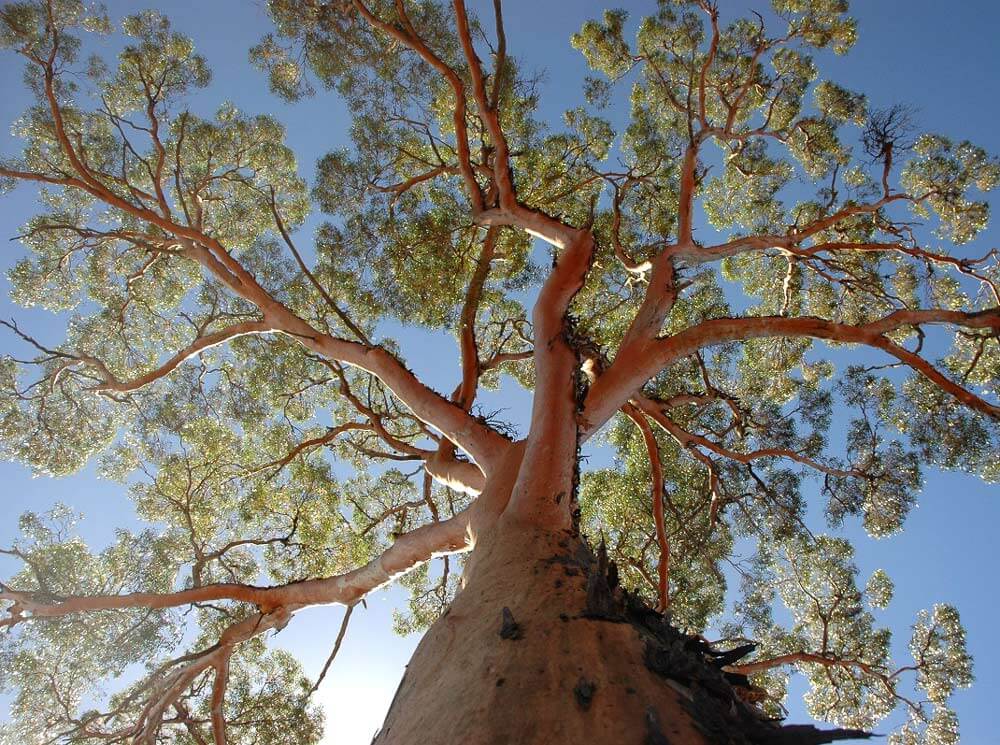A dying gum tree can be saved if caught early, but before you can save it, you need to first figure out the reason why it is dying. There are many reasons that can contribute to your Gum tree dying including but not limited to:
- Is under attack from pests or diseases
- Has suffered a significant physical trauma
- Doesn’t have access to adequate water
- Is struggling with finding enough nutrients to sustain its growth
- Is being starved of sunlight, or
- Is being exposed to low temperatures
- Changed environmental conditions such as soil compaction
Here is everything that you should know about dying gum trees.

The most common causes of gum tree death are:
- Diseases like canker disease, armillaria root rot, heart rot, powdery mildew, leaf spots disease, and anthracnose
- Pests like the gall makers, psyllids, eucalyptus snout beetle, long-horned borer, omnivorous looper, tortoise beetle, and giant whitefly.
- Unfavorable environmental conditions like a lack of sufficient nutrients, excess nutrients, a lack of moisture, too much moisture, frost, and edema.
- Physical trauma. This may be due to accidentally cutting its roots, damage from storms, being eaten by animals, or poor tree management practices like topping.
Fungal and bacterial attacks
Bacterial and fungal attacks are a common causes of eucalyptus tree death. These attacks kill trees by interfering with the tree’s ability to protect itself, produce food, transport food, support itself, or absorb nutrients and water.
The most common fungal and bacterial conditions that affect gum trees include:
Myrtle rust
Myrtle rust is a serious disease that can kill gum trees. It is caused by Puccinia psidii, a fungus. And it often presents by causing a leaf to turn gray or brown.
However, before the changes, you might notice your tree’s leaves develop powdery spots that are bright yellow. These leaves then change their shape. Eventually, they shrivel and fall off. As a result, your gum tree will become stunted and may end up dying.
Teratosphaeria disease
Another disease that affects gum trees is the Teratosphaeria disease. This is a disease that mostly affects the leaves of gum trees and it often causes your tree to lose its leaves.
They often start by causing spots on leaves. Then the leaves develop blight. Eventually, the leaves die and fall off.
Cankers
These are fungal infections that damage a tree’s bark.
They gradually kill the bark. This makes the tree vulnerable to disease and pest attacks. They also disrupt the tree’s ability to move nutrients and water. This essentially strangles it and starts killing it.
Phytophthora
This is another tree fungus that targets gum trees. It often starts by discoloring leaves. It eventually turns a tree’s wood dark brown. And the stress that it eventually causes can kill the tree.
Heart or trunk rot
If your gum tree has drooping branches, then chances are that it is rotting from the inside. This is a fungus that slowly destroys gum trees.
Bacterial root rot
If your eucalyptus tree’s stems and leaves start developing brown spots, then you have a bacteria problem. Bacteria are possibly attacking its roots, causing root rot. And if this problem is extensive, it may start to kill the tree.
Pests
Most pests physically destroy gum trees by burrowing into them. Some target their leaves. Others target their trunks and stems.
With time, this burrowing exposes the trees to diseases and infections. It also compromises the ability of the gum trees to sustain themselves. And so in most cases, the attacked trees tend to die.
Therefore, if your gum tree is dying, pests might be to blame. And chances are that one of the following pests might be to blame.
- Giant white flies
- Roundheaded borers
- Psyllids
- Glassy-winged sharpshooters
- Eucalyptus gall wasps
- Foliage-feeding caterpillars
- Snout beetles
- Eucalyptus tortoise beetles
Environmental factors
Your tree may be dying because it is in an unfriendly environment. These include:
Low moisture availability. Like every other plant, gum trees need water to survive. Without it, its leaves will wilt and dry out. This will compromise its ability to produce food.
The plant will also become stressed out. And this will leave it vulnerable to other attacks.
All of these factors will end up killing the tree.
Overwatering. While a gum tree needs water in order to survive, you can still kill it by overwatering. This is because overwatering makes it harder for the tree’s roots to breathe. It also increases the odds of disease and pest attacks. Either of these things can kill the plant.
Frost and freezing. Gum trees are not equipped to deal with extremely low temperatures.
When they are, the trees’ leaves will start to change color, curl, and eventually die. It will start cracking — this includes its bark and wood. Eventually, the plant will start dying.
Physical injury
When a gum tree is physically injured, it can start to die. This will be the case if the injury is severe enough to compromise its defense system, or significant enough to a point where it interferes with its core functions.
A tree will die if its bark is removed or if a significant portion of it is cut. It will also start dying if its roots are either cut off or subjected to enough physical trauma to the point where they die. And for small gum trees, being eaten by animals is enough to kill them.
Storms, animals, machinery, and people, are all common causes of gum tree death because they can cause enough damage to a tree’s physical structure to such an extent that the tree can’t recover.
What can you do to keep your gum tree from dying?
A typical gum tree has an incredibly elaborate defense system. It can effectively defend itself against attacks by deploying a number of strategies that include:
- Physical barriers like the tree’s bark, lignin, and pectin.
- Secretory glands and ducts that manufacture compounds that fight off diseases and other harmful agents.
- Metabolites and peptides that have antimicrobial properties and can deploy against insects and other pests.
- The ability to reinforce tissues and isolate the rest of the tree from infected or affected areas.
Therefore, most of the time, all that you have to do is to give it a chance to fight off whatever it is that is killing it. As a result, your tree will have a better chance of recovering and surviving by simply alleviating its stress and making it easier for it to defend itself.
What exactly should you do?
You should:
Prune the tree – Trees always maintain a balance above and below ground, so root volume mirrors branches to feed it enough nutrients as it grows. But by reducing the above-ground branches by 30% with a good prune, you are tipping the balance in the favor of the roots which only need to maintain 70% of the tree, so they can use excess energy stores to heal itself.
Solve watering issues. If the plant is receiving insufficient water, you should water it. If it is being overwatered, you should improve aeration and drainage around the tree.
Fertilize. A lack of sufficient nutrients causes a tree to be unnecessarily stressed out. This often leaves trees vulnerable to attacks. There being insufficient nutrients also means that the tree starves as it is robbed of the ability to make enough food to sustain its survival.
Fertilization ensures that a tree has easy access to nutrients. This reduces the stress that it is under. It improves its ability to fight off diseases. And it allows the tree to produce enough food to sustain its growth.
Apply pesticides. Pesticides kill pests. And if you apply them in time, before they can cause irreversible damage to your tree, you can save your tree from certain death.
Are you looking for a tree care expert near you?
If you need help saving a dying gum tree, GoTreeQuotes.com offers a FREE service that quickly matches you with the top-voted local tree care experts in your area.
You can get 3 estimates fast by real certified experts in your area in just 2 minutes. Here is how it works.
- You scroll to the top of the page and enter your Zip code.
- Answer questions about your tree care needs
- Your details will be forwarded to three local experts.
- You will then receive a price estimate for the job and some friendly advice.
IMPORTANT: There is no obligation to hire. This is a free tool and service to be used at your pleasure.




